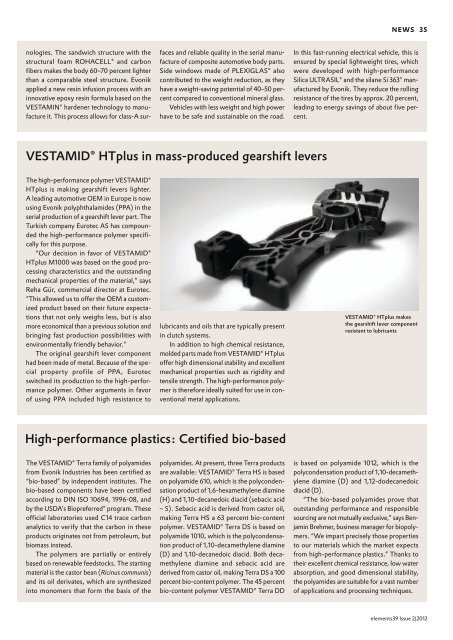Download - Evonik Industries
Download - Evonik Industries
Download - Evonik Industries
Create successful ePaper yourself
Turn your PDF publications into a flip-book with our unique Google optimized e-Paper software.
nologies. The sandwich structure with the<br />
structural foam ROHACELL® and carbon<br />
fibers makes the body 60–70 percent lighter<br />
than a comparable steel structure. <strong>Evonik</strong><br />
applied a new resin infusion process with an<br />
innovative epoxy resin formula based on the<br />
VESTAMIN® hardener technology to manufacture<br />
it. This process allows for class-A sur-<br />
veStAMID® Htplus in mass-produced gearshift levers<br />
The high-performance polymer VESTAMID®<br />
HTplus is making gearshift levers lighter.<br />
A leading automotive OEM in Europe is now<br />
using <strong>Evonik</strong> polyphthalamides (PPA) in the<br />
serial production of a gearshift lever part. The<br />
Turkish company Eurotec AS has compounded<br />
the high-performance polymer specifically<br />
for this purpose.<br />
“Our decision in favor of VESTAMID®<br />
HTplus M1000 was based on the good processing<br />
characteristics and the outstanding<br />
mechanical properties of the material,” says<br />
Reha Gür, commercial director at Eurotec.<br />
“This allowed us to offer the OEM a customized<br />
product based on their future expectations<br />
that not only weighs less, but is also<br />
more economical than a previous solution and<br />
bringing fast production possibilities with<br />
environmentally friendly behavior.”<br />
The original gearshift lever component<br />
had been made of metal. Because of the special<br />
property profile of PPA, Eurotec<br />
switched its production to the high-performance<br />
polymer. Other arguments in favor<br />
of using PPA included high resistance to<br />
faces and reliable quality in the serial manufacture<br />
of composite automotive body parts.<br />
Side windows made of PLEXIGLAS® also<br />
contributed to the weight reduction, as they<br />
have a weight-saving potential of 40–50 percent<br />
compared to conventional mineral glass.<br />
Vehicles with less weight and high power<br />
have to be safe and sustainable on the road.<br />
lubricants and oils that are typically present<br />
in clutch systems.<br />
In addition to high chemical resistance,<br />
molded parts made from VESTAMID® HTplus<br />
offer high dimensional stability and excellent<br />
mechanical properties such as rigidity and<br />
tensile strength. The high-performance polymer<br />
is therefore ideally suited for use in conventional<br />
metal applications.<br />
High-performance plastics: Certified bio-based<br />
The VESTAMID® Terra family of polyamides<br />
from <strong>Evonik</strong> <strong>Industries</strong> has been certified as<br />
“bio-based” by independent institutes. The<br />
bio-based components have been certified<br />
according to DIN ISO 10694, 1996-08, and<br />
by the USDA’s Biopreferred® program. These<br />
official laboratories used C14 trace carbon<br />
analytics to verify that the carbon in these<br />
prod ucts originates not from petroleum, but<br />
biomass instead.<br />
The polymers are partially or entirely<br />
based on renewable feedstocks. The starting<br />
material is the castor bean (Ricinus communis)<br />
and its oil derivates, which are synthesized<br />
into monomers that form the basis of the<br />
polyamides. At present, three Terra products<br />
are available: VESTAMID® Terra HS is based<br />
on polyamide 610, which is the polycondensation<br />
product of 1,6-hexamethylene diamine<br />
(H) and 1,10-decanedoic diacid (sebacic acid<br />
– S). Sebacic acid is derived from castor oil,<br />
making Terra HS a 63 percent bio-content<br />
polymer. VESTAMID® Terra DS is based on<br />
polyamide 1010, which is the polycondensation<br />
product of 1,10-decamethylene diamine<br />
(D) and 1,10-decanedoic diacid. Both decamethylene<br />
diamine and sebacic acid are<br />
derived from castor oil, making Terra DS a 100<br />
percent bio-content polymer. The 45 percent<br />
bio-content polymer VESTAMID® Terra DD<br />
neWs<br />
In this fast-running electrical vehicle, this is<br />
ensured by special lightweight tires, which<br />
were developed with high-performance<br />
Silica ULTRASIL® and the silane Si 363® manufactured<br />
by <strong>Evonik</strong>. They reduce the rolling<br />
resistance of the tires by approx. 20 percent,<br />
leading to energy savings of about five percent.<br />
veStAMID® Htplus makes<br />
the gearshift lever component<br />
resistant to lubricants<br />
is based on polyamide 1012, which is the<br />
polycondensation product of 1,10-decamethylene<br />
diamine (D) and 1,12-dodecanedoic<br />
diacid (D).<br />
“The bio-based polyamides prove that<br />
outstanding performance and responsible<br />
sourc ing are not mutually exclusive,” says Benjamin<br />
Brehmer, business manager for biopolymers.<br />
“We impart precisely those properties<br />
to our materials which the market expects<br />
from high-performance plastics.” Thanks to<br />
their excellent chemical resistance, low water<br />
absorption, and good dimensional stability,<br />
the polyamides are suitable for a vast number<br />
of applications and processing techniques.<br />
35<br />
elements39 Issue 2|2012
















